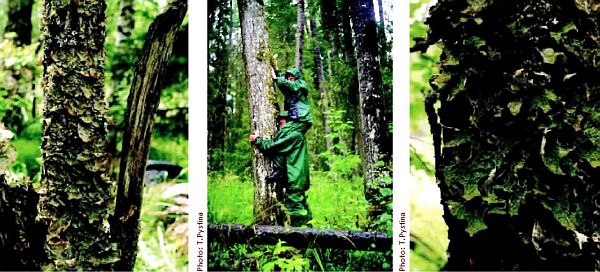BRIEF PREHISTORY OF PROJECT
The Project is initiated by a Swiss lichenologist Christoph Scheidegger. He is famous for his works on ecology of lichens indicating old-growth forests and on population biology of rare lichen species. C. Scheidegger paid special attention to the studies of biology and ecology of epiphytic lichen Lobaria pulmonaria.
Lobaria pulmonaria is a conspicuous foliose lichen species that was common in pre-industrial periods in humid temperate and boreal regions of the Northern Hemisphere, and cooler part of the tropics. During the last decades, population of this lichen considerably declined in most parts Central Europe. The major threat to this species is the established practice of forestry management leading to destruction of old-growth humid forests, and air pollution, even at low levels (Scheidegger & Schroeter, 1995). Considering that lichen is a symbiotic organism, its reproduction is a very complex process, which often limits the population size in a changing environment. The research performed by C. Scheidegger in Switzerland showed that the present small population size of Lobaria pulmonaria is limited by a low rate of successful recolonization events in managed forests, which causes local extinction even under favorable conditions (Scheidegger 1995; Scheidegger, Frey & Zoller 1995). For conservation purposes, in Switzerland there were performed successful attempts to increase population size by additional transplantation of thallus fragments and vegetative diaspores (Scheidegger 1995; Scheidegger et al. 1995; Scheidegger, Frey, Walser, 19998). Recent published results revealed that genetic variability of nuclear ribosomal large subunit (nLSU) and of the internal transcribed spacer (ITS1) of Lobaria pulmonaria from Central Europe allowed the detection ofdiverse and impoverished populations (Zoller, Lutzoni & Scheidegger 1999a; Zoller, Scheidegger & Speris-en 1999b). New approaches to studies of population biology of rare species were leaborated and tested in Central Europe. It was necessary to test recently developed methods in a continent-wide level.
During the present Project, for the first time population biology and conservation activities grounded upon scientific approach. Especially the hypothesis of how small populations would improve their conservation status through inoculation of additional trees with Lobaria pulmonaria was tested. Moreover, transplantation of the lichen originating from various regions will show whether there are regional differences in Lobaria pulmonaria concerning ecotypes with various characteristics of growth and development. The awaited result was to find out if the lichen contains several ecotypes and to check a hypothesis if the ecotype is connected with the genetic type.
If we keep in mind that the East Asia, including the Far East, is the area of the greatest genetic diversity of Lobaria, we can test the hypothesis that genetic diversity is the highest in the East and gradually declines westwards. The data on genetic variation allows one to define the future priorities for conservation of local population of Lobaria pulmonaria. For the first time, scientific survey comprised the major part of species distribution area.
DATES OF IMPLEMENTATION OF PROJECT
2001-2003
FUNDING ORGANIZATION
Swiss National Science Foundation (SNSF)
PROJECT CO-ORDINATOR
PD Dr. Christoph Scheidegger Swiss Federal Institute for Forest, Snow and Landscpae Research, WSL, 8903, Birmensdorf
RESPONSIBLE SCIENTIST
Dr. Tatyana Pystina (on behalf of Institute of Biology)



